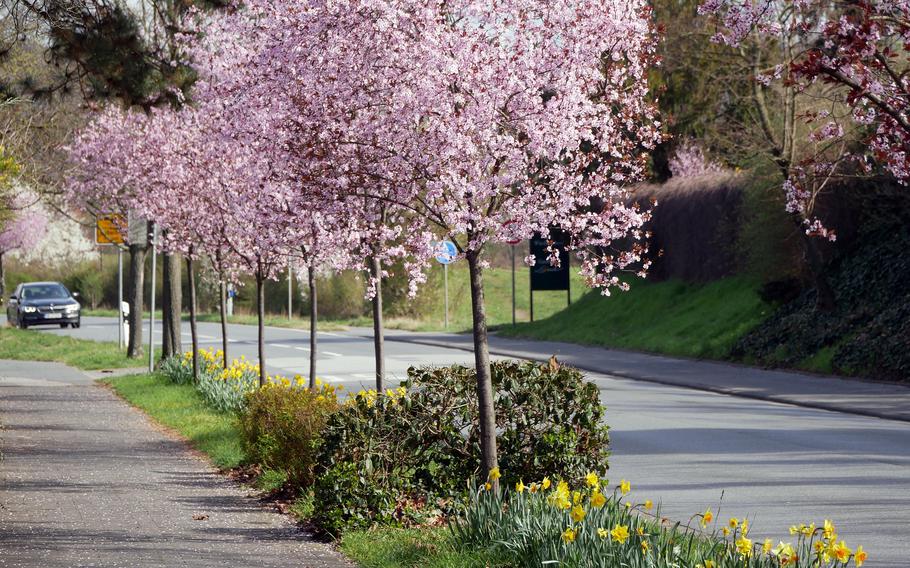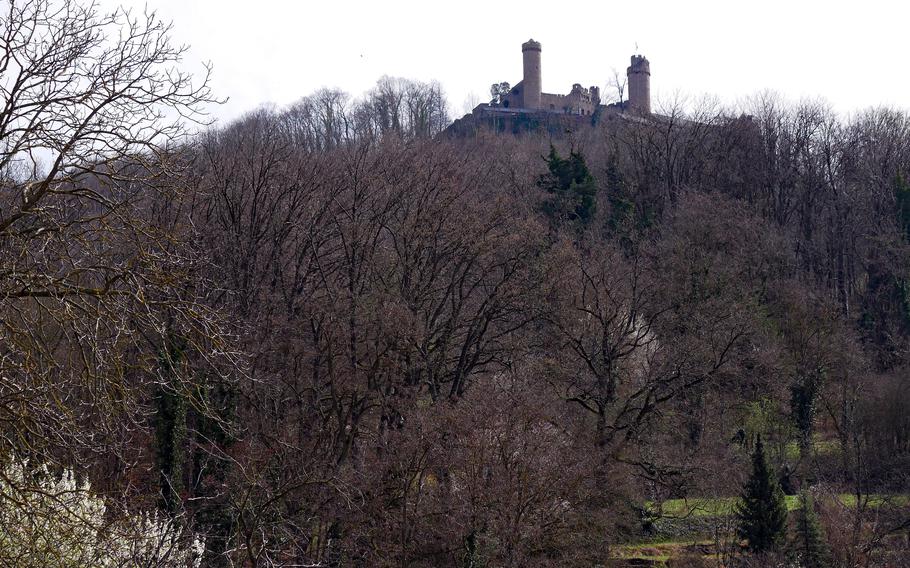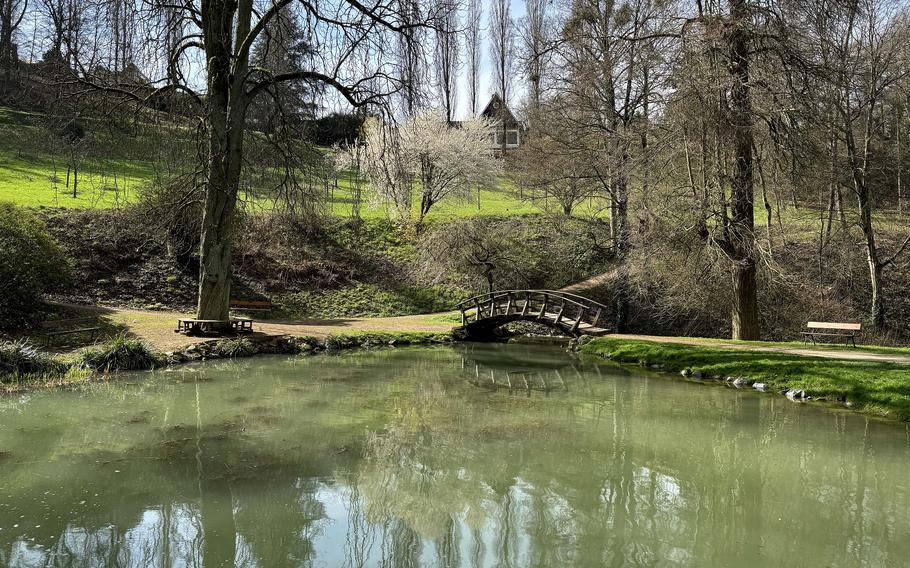
Trees lining the Bergstrasse are in full bloom in Alsbach, Germany. The Bergstrasse, or mountain road, runs from the outskirts of Darmstadt in the north, to Heidelberg in the south. (Michael Abrams/Stars and Stripes)
The Bergstrasse, literally mountain road, is famous for its castles, wines, villages and its fruit trees that bloom here earlier than almost anywhere else in Germany.
From the outskirts of Darmstadt, it runs for about 33 miles to the banks of the Neckar River at Heidelberg, with its famous castle.
On a recent sunny, early spring day, we drove the Bergstrasse from north to south, with stops along the way.
Leaving Darmstadt behind, we followed the signs to Malchen and Seeheim-Jugenheim along highway B3.
In Malchen, you might get a peek at the twin towers of Frankenstein castle on a hill behind the town. But between here and Seeheim, you’ll see orchards on both sides of the road — especially now in the spring, when the fruit trees bloom in vibrant shades of white, yellow and pink.
Emperor Joseph II supposedly remarked while visiting the Bergstrasse in the spring of 1764 that “... this is where Germany begins to become Italy.”
The region can thank the Odenwald for its mild climate and early blooming flora. The range, more hills than mountains, offers enough protection from the cold eastern winds for the Bergstrasse to have higher average annual temperatures than most of Germany.
Seeheim and Jugenheim, the two villages that make up the hyphenated municipality, are known for their high-priced real estate. But Seeheim has a 16th century town hall that is a fine example of half-timbered architecture of the period.
Zwingenberg was the first town on the Bergstrasse to be awarded the right to call itself a city. That happened in 1274. The medieval old town climbs the hillside along narrow cobblestone lanes to the 13th century Bergkirche, or mountain church.
From the north, Zwingenberg is the first town on the Bergstrasse with its old center dominated by half-timbered houses. It is also the first one along the way surrounded by vineyards.
The Bergstrasse is the second smallest wine region in Germany. Several of the wines produced here, while not well known internationally, are quite good.
Next stop on the road is the village of Auerbach, now a suburb of Bensheim.

Auerbach castle towers over the village of the same name, on central Germany's Bergstrasse. Literally mountain road, the highway runs from Darmstadt to Heidelberg hugging the hillsides and has many towns and castles worth visiting. (Michael Abrams/Stars and Stripes)
Before you reach the town, you’ll see Auerbach Castle towering above it. Built in the 13th century, it offers an excellent view of the Odenwald, the Bergstrasse and the Rhine River valley.
The Fuerstenlager, the summer residence of the counts of Hesse-Darmstadt, is on the outskirts of town in the middle of a large park that is worth visiting.

The Fuerstenlager, or Princes’ Camp in Bensheim-Auerbach, is a peaceful place to visit when traveling along the Bergstrasse. It was once a rural summer residence for the House of Hesse-Darmstadt. (Michael Abrams/Stars and Stripes)
Bensheim dates to 765 and the years have left much to see. Historical houses, beautiful fountains, a lively marketplace and a large pedestrian shopping area are among them. When the weather is warm people fill the outdoor cafes, and in the fall the town hosts a popular wine festival.
An acquaintance once remarked that there are only two times a year to visit the Bergstrasse — in spring when it’s in bloom and in the fall when the grapes are ripe.
Grapes have been ripening in the vineyards around Heppenheim ever since the Romans brought viticulture to the area about 2,000 years ago.
Highlights of Heppenheim are the Marktplatz (marketplace) and city hall, 18th century half-timbered houses and the market fountain topped by an 18th century Madonna, at least when it’s not being restored. Near the marketplace is the St. Peter’s Church, started in the 11th century, which is sometimes called the cathedral of the Bergstrasse.
Farther down the road, Weinheim has two castles watching over it. One is the newest on Bergstrasse, the other the second oldest.
Wachenburg was built early in the 20th century by local fraternities in memory of their members killed in the 1870-71 war against France.
Windeck was built, destroyed and rebuilt in the 12th century, then destroyed again in 1674. The ruins are owned by the city and can be visited either by driving up a winding road or hiking up a well-marked path.
If you are looking for a place for lunch, Weinheim’s restaurant-lined marketplace might be the place to find it. Afterward, check out the Schlosspark, which invites one to a nice post-lunch stroll past flower beds, ancient trees, a small lake and playgrounds for the kids.
Before leaving town, check out the Gerberbachviertel, the old tannery district.
An open stream flows where tanners once worked animal hides for leather. That is all gone, but the district, with its old houses, small squares and colorful flower boxes is worth the visit.
In Schriesheim, take a walk through the vineyards to Strahlenberg castle before the final jaunt down the Bergstrasse to Heidelberg.
On the QT
Times: Anytime, but the best time is between late March and October. Most of the towns have a Christmas market. The ones in Bensheim and Weinheim are most popular.
Getting there: The Bergstrasse runs along federal highway B3. Driving south, a good place to start is at Malchen or Seeheim-Jugenheim. Heading north, the Heidelberg district of Neuenheim is a good starting point. B3 often skirts past the town centers, so in towns, follow signs to Stadtmitte or Ortsmitte.
Parking: All the towns have free parking for an hour and sometimes two if you use a parking dial. Any longer and you’ll probably have to pay.
Bicycling: It’s mostly flat biking down; the tough spots are where the town centers are uphill from the highway (Heppenheim, Weinheim).
Hiking: Most of the towns have marked paths through the vineyards and orchards, and to the castles. One trail leads from Zwingenberg to Heppenheim, and every May 1, the vintners offer their wines at stands along the way.
Information: Online: diebergstrasse.de (in German). Bensheim, Heppenheim and Weinheim all have tourist information offices.